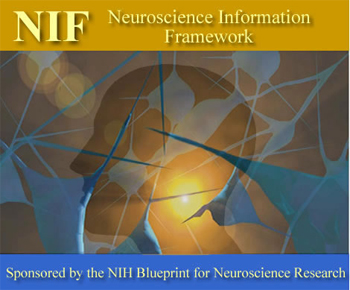Helping to Unravel the Hidden Web of Neuroscience Information
UC San Diego Researchers Debut Neuroscience Information Framework NIF 2.0 at 'Neuroscience 2009'
San Diego and Chicago, October 17, 2009 -- Decades of investment in neuroscience by agencies such as the National Institutes of Health has led to an explosion of new information about the brain. Global communications networks promote around-the-clock collaborations, in a world saturated with information.
|
Ironically, the tidal wave of data makes it harder for researchers to locate relevant neuroscience resources, such as data, tools and materials, because information is scattered across thousands of databases and billions of web pages.
At “Neuroscience 2009” – the largest international meeting of neuroscientists, being held in Chicago this week – researchers from a national collaboration led by the University of California, San Diego will debut major enhancements to an information framework for tackling the significant problems of information retrieval in the neurosciences.
The enhancements being introduced this week include a completely redesigned site to provide for improved navigation and usability – tools that are critical to neuroscientists in an age of information overload.
“Despite the ready access provided by powerful on-line search engines, most don't access data within separate databases particularly well,” said Maryann E. Martone, PhD, professor of neurosciences at UC San Diego School of Medicine, who helped head the project. “As a result, much of this valuable information is hidden from search engines, comprising the so-called "hidden web." Adding in the complexity and range of scientific jargon, with each database or web page using its own custom terminology, further confounds search engines that rely on key words and phrases to retrieve information.”
Recognizing this huge hurdle, and in preparation for the 39th annual meeting of the Society for Neuroscience, the Neuroscience Information Framework (NIF) released NIF 2.0 on October 12th. NIF 2.0 incorporates the NeuroLex ontology to improve searches and expands the availability of NIF resources as open access data, according to the UC San Diego team. As part of this focus on data, NIF 2.0 includes a substantial increase in content making NIF one of the largest federations of databases available. With its release, the Society for Neuroscience will be transitioning its Neuroscience Database Gateway (NDG) to the NIF platform. The NIF builds upon the foundation of the NDG, and integrates a unique set of tools tailored especially for neuroscientists.
“The annual meeting of the Society for Neuroscience is a testament to the vibrancy and diversity of neuroscience endeavors, highlighting research that helps us better understand the brain and perhaps will help stop the devastating consequences of brain diseases,” said Martone, whose team is based in Calit2's headquarter building on the UCSD campus. “With the simultaneous revolution in information technology, neuroscience researchers are increasingly able and eager to share data through means other than traditional scientific publications, making them available through on-line databases and web pages. We believe that NIF can accelerate the pace of discovery by making data accessible.”
NIF enables access to hidden web resources that cut across traditional boundaries - from experimental, clinical and translational neurodatabases to knowledge bases, atlases, and genetic/genomic resources. “Considering this ever-increasing and diverse inventory, NIF is an information management breakthrough,” Martone added. “And with more participation from the scientific community the NIF gets better and better.”
About the Neuroscience Information Framework
U.S. scientists developed the NIF to help indentify, relate, and integrate information from the world-wide neuroscience community to meet the challenge of navigating oceans of data. Martone, along with co-principal investigators Jeffrey Grethe, Ph.D., and Amarnath Gupta, Ph.D., lead this national collaboration that includes researchers at Yale University, the California Institute of Technology, George Mason University and Washington University, St. Louis.
NIF (http://www.neuinfo.org) is a neuroscience-centered web portal, providing simultaneous, deep web searches across multiple databases, web pages and literature, including those invisible to traditional search engines. Developed in a collaboration of neuroscientists and computer scientists, NIF utilizes open source web tools, advanced search technologies and neuroscience terminologies to provide a unique discovery environment.
Its goal is to advance neuroscience research by enabling discovery and access to public research data and tools worldwide through an extensible and evolvable network infrastructure. Here, researchers, students and educators can access and manipulate data to find specific answers to questions and develop new hypotheses about how the brain works.
Unlike more general search engines, NIF digs deep into the web uncovering the most focused set of relevant resources and specific pieces of information with search strategies tailored to neuroscience. NIF combines open source tools, advanced technologies and human curators for locating and accessing neuroscience resources. It employs a dynamic inventory of web-based neurosciences resources: data, materials, and tools for scientists and students to access via any contemporary computer connected to the Internet.
Underlying the NIF system is a comprehensive vocabulary for describing neuroscience resources that allows users to perform "concept-based searches" in additional to traditional string-based searches. Concept-based searches seek contextual information according to the meaning of a term rather than the term itself. For example, a concept-based search would distinguish between "cell" as part of the body versus "cell" as in cell phone.
As researchers register their resources and utilize the NIF vocabularies, they contribute to a free, richly populated ecosystem of neuroscience information to speed new discoveries to improve human health.
Established in 2005, NIF is an initiative of the NIH Blueprint for Neuroscience Research, a cooperative effort of 16 NIH institutes, centers, and offices. NIF provides an important resource for neuroscience researchers and the community-at-large, including other scientists, students, clinicians, and administrators as well as the general public. For more information about the Blueprint visit http://neuroscienceblueprint.nih.gov/.
Related Links
Center for Resarch in Biological Systems
Neuroscience Information Framework
NIH Neuroscience Blueprint
Media Contacts
Debra Kain, 619-543-6163, ddkain@ucsd.edu


